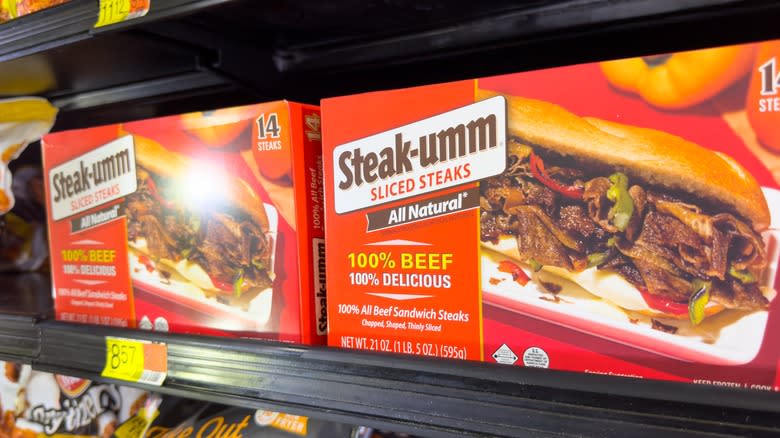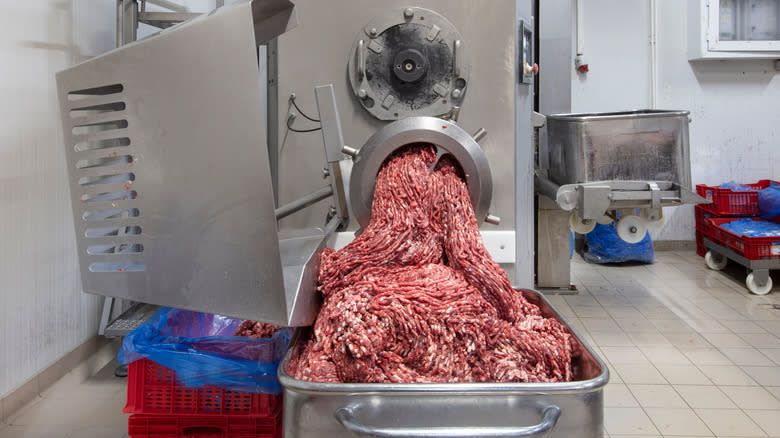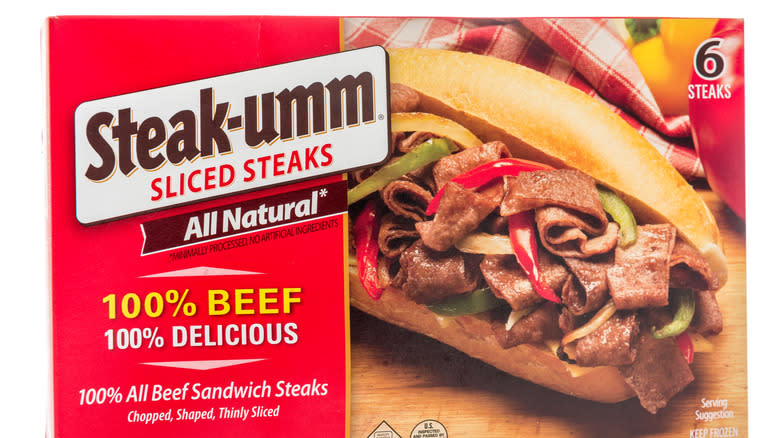What Kind Of Meat Is Steak-Umm Made Of?

We may receive a commission on purchases made from links.
If you grew up in the '70s and '80s, you know that it was the era of Steak-Umms. These thin slices of meat hit the scene in 1969 thanks to their invention by Gene Gagliardi, an heir to a Philadelphia-based meat business. Later it became iconic to the unsupervised so-called latchkey kids of that time who needed something easy to cook without burning the house down. The super-thin steaks reigned supreme during that golden age of processed food, but they also earned a bit of an ugly reputation from people who thought they were some sort of mixed or fake meat. Steak-Umms, however, have always been made with 100% percent beef, which it says right on the front of the box.
Steak-Umms are not, however, made with prime cuts of sirloin and tenderloin. It's actually made by processing trimmed parts that are leftover after the major cuts of a cow are removed. So while it's indeed made with beef, it is also definitely processed, which is why people tend to think of Steak-Umms as some sort of mystery meat. Don't believe the naysayers, however, because Steak-Umms is definitely beef through and through.
Read more: What These Imitation Foods Are Actually Made Of
How Steak-Umms Came To Be

It's no accident that Steak-Umms originated in the Philadelphia area, which is widely known as the home of the steak and cheese sandwich. Pressed for ways to keep their family business afloat, Gagliardi had the idea to create a "homogenized" beef product that could be thinly sliced and easy to chew in a steak and cheese, according to Mental Floss. He gathered some beef scraps and ran them through a meat grinder several times until the meat was smooth, had it pressed into a loaf, and then froze it so that it was sliceable. At first, they had to sell it below cost to grocery stores but then hit pay dirt when they started selling to schools for lunches. Kids loved the thin, meaty slices and the rest was history. "Kids ate it, loved it, then went home and asked for it," Gagliardi told Mental Floss.
Steak-Umms later fell out of favor when consumers became more concerned with fat and cholesterol, but with the rise of low-carb and keto diets, Steak-Umms are back on the menu for a new generation of meat eaters. They even enjoyed a social media moment during the COVID-19 pandemic after sending out a few savvy tweets (per NC State).
When In Doubt, Read The Ingredients

If you're still skeptical about what's in a Steak-umm, flip the package over and read the ingredients, which includes just one ingredient: Beef. In the U.S., foods can make a lot of claims on the front of packages, but when it comes to the food label there are strict rules, and all the ingredients must be declared. The USDA states, "On a product label, the ingredients are listed in descending order of predominance by weight, with the ingredients used in the greatest amount first, followed by those in smaller amounts."
The process of making Steak-Umms is not much different from grinding meat for hamburgers or sausages, it's just a much finer grind, so think of them in those terms. Take it from the internet, where the thin slices have a lot of fans. And if you're late to the Steak-umm game it's never too late to give them a try. They're still widely available at most grocery stores.
"I grew up lower middle class. Saw the Steak-umm ads on TV in the 80s and 90s. Wanted to buy some so bad, but mom always said they were an indulgence that we could not afford," said a Redditor. "Fast forward many years, and I see them at my local Food City. So, I picked some up and made my dream finally come true. Bonus: they are delicious!"
Read the original article on Daily Meal.

